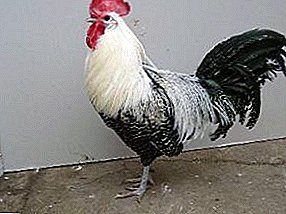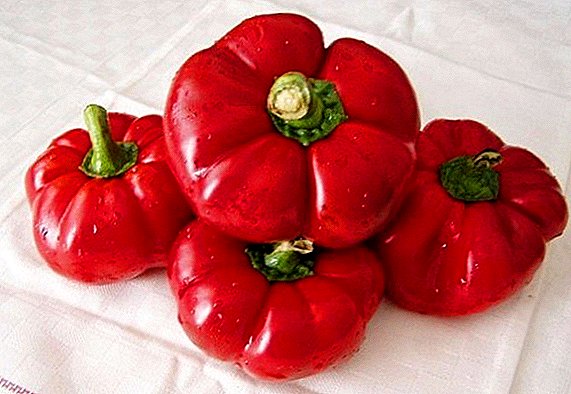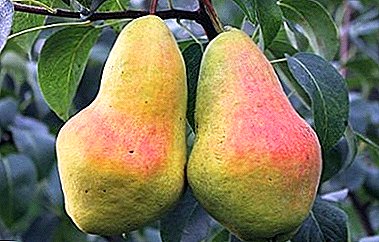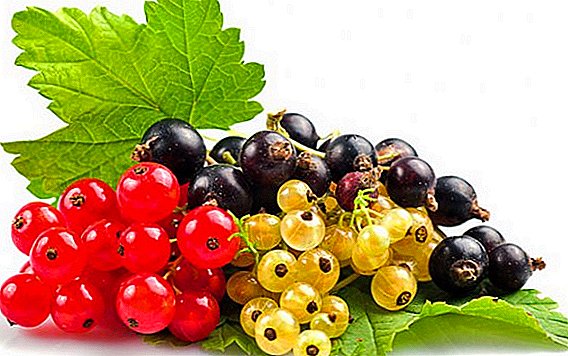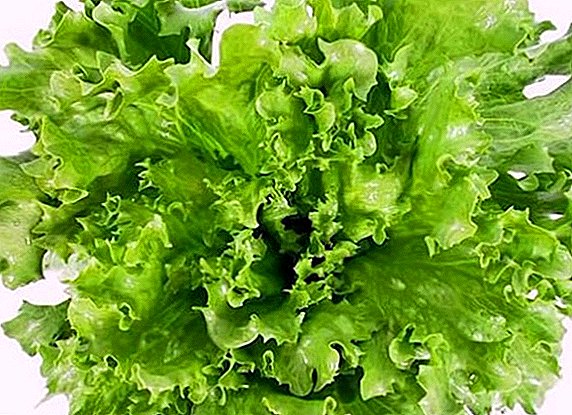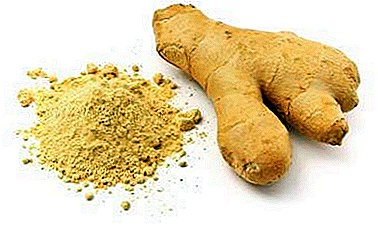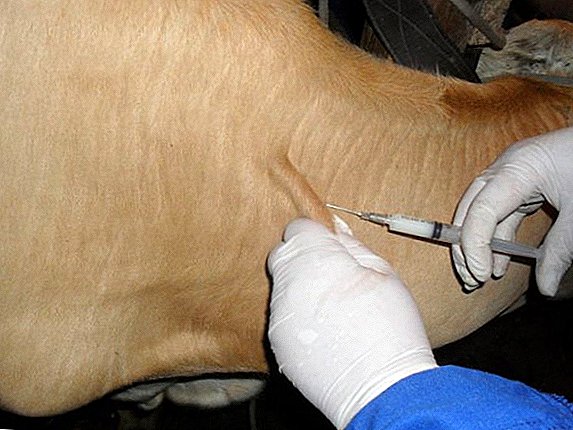 Vaccination of cattle is as important as vaccinations of other farm animals, so do not neglect it. Depending on the age category of the animal, different vaccines can be used, but basically all of them are aimed at preventing salmonellosis, foot and mouth disease, parainfluenza, anthrax and a whole list of other, no less dangerous ailments. Let's consider the scheme of vaccination of cattle more closely.
Vaccination of cattle is as important as vaccinations of other farm animals, so do not neglect it. Depending on the age category of the animal, different vaccines can be used, but basically all of them are aimed at preventing salmonellosis, foot and mouth disease, parainfluenza, anthrax and a whole list of other, no less dangerous ailments. Let's consider the scheme of vaccination of cattle more closely.
Vaccination of newborn calves (dispensary 1-20 days)
Newborn calves are more susceptible to disease than others, because natural protection lasts not for long. Already from the second week of life, they are beginning to be vaccinated, and the first vaccines include drugs for viral diarrhea, salmonellosis, diplococcal septicemia, infectious rhinotracheitis, parainfluenza and foot and mouth disease. 
Viral diarrhea
This is an extremely unpleasant disease of infectious nature, which is characterized by lesions of the mucous membranes of the digestive tract of the calf. Sometimes viral diarrhea is associated with stomatitis, but most often the main symptoms are painful cough, mucopurulent discharge from the nasal passages, ulcers and erosion in the mouth, tachycardia, diarrhea and fever.
To prevent infection of newborn calves, a dry culture vaccine vaccine is usually used, and for the first time a 10-day calf is inoculated, and the second is given 20 days later, that is, at the age of one month. The dosage of the diluted drug per calf is 3 cu. cm.
Did you know? If the cow and calf had not parted for three years, then all this time she would have fed her baby with milk. However, in the conditions of farms this is impossible, because the young do not stay long with their mother.
Salmonellosis
Another infectious disease affecting the digestive tract of calves. In the acute course of the disease, enteritis and sepsis may occur, and in the chronic form pneumonia appears. If the calf was born from a vaccinated cow, then the first vaccine against salmonellosis is performed at 20 days of age with repeated revaccination after 8-10 days, and if from an unvaccinated animal, it means that the vaccine must be used earlier - at 5-8 days of age, with repeated after five days.  The most successful drug in this case is considered to be a concentrated form-alumina vaccine, used for the first time in a dosage of 1.0 cu. cm per calf and 2.0 cu. cm - with revaccination.
The most successful drug in this case is considered to be a concentrated form-alumina vaccine, used for the first time in a dosage of 1.0 cu. cm per calf and 2.0 cu. cm - with revaccination.
Diplococcal septicemia
The disease is characterized by the appearance of sepsis and inflammation of the joints, most often affecting young individuals between two weeks and 2.5 months. It is possible to prevent the development of ailment by timely vaccination of a calf at the age of eight days, with repeated vaccination in two weeks, which is not only calves, but also lambs and pigs used for the vaccine against diplococcal septicemia. The first time 5 ml of vaccine is used, and with revaccination, the dose is increased to 10 ml.
Important! It is desirable to draw the drug into the syringe only after shaking it thoroughly, until a completely homogeneous composition is obtained.
Infectious rhinotracheitis and parainfluenza-3
Infectious rhinotracheitis is a contagious disease, manifested mainly by catarrhal-necrotic processes in the upper respiratory tract of the calf, which, in turn, causes fever, conjunctivitis and general indisposition of the animal. The parainfluenza is the same contagious disease, therefore the symptoms of these diseases are similar.  In order to prevent both diseases, a dry associated vaccine against parainfluenza-3 and rhinotracheitis is used, which is first administered to calves at ten days of age, and then revaccination is carried out after 25 days. Single dose - 3 cu. see intramuscularly (in the croup zone).
In order to prevent both diseases, a dry associated vaccine against parainfluenza-3 and rhinotracheitis is used, which is first administered to calves at ten days of age, and then revaccination is carried out after 25 days. Single dose - 3 cu. see intramuscularly (in the croup zone).
Foot and mouth disease
Foot and mouth disease is a viral disease of cattle and many other animals, characterized by increased salivation and body temperature and erosive lesions of the oral cavity, limbs, and mammary glands. But the worst thing is that a person can suffer from this disease, so in those farms where the vaccination has not been done before, newborn calves are vaccinated from the first day of life, using serum or blood of convalescents, or hyperimmune serum.
Did you know? Newborn calves sleep up to 10 hours a day, preferring to spend more time lying down. At the same time, their sleep is always very deep and calm, which distinguishes these babies from human babies.
Later, after two months of age, you can use hydroxide aluminum vaccine from lapinized cultured virus, in a dosage of 5 ml per animal.
Vaccine for young stock
The term "maintenance young" means animals intended to replenish the herd instead of retired individuals. Often they are descendants of high-performance breeding cows, and therefore much more valuable. Naturally, they are also organized at the highest level, which is reflected even in the vaccination scheme, divided into two main periods. 
The first period (20-90 days)
Many farmers consider this time as the most crucial period in the entire vaccination scheme. This is especially true of farms where cases of animal mortality have already been recorded, and vaccinations are required as soon as possible. Revaccination is also carried out right now.
Viral diarrhea
If the owner has seriously approached the issue of vaccinating calves, then at one month old they should receive a second vaccination against viral diarrhea, which is still performed using dry culture virus vaccine at the same dosage.
Did you know? Contrary to popular belief, a cow is quite an intelligent and social animal. She perfectly recognizes the owner after his long absence and responds to her name, and is also able to express compassion and sympathy towards her fellow tribesmen, sometimes even with tears.
Salmonellosis
At 25 days of age, many calves can get their first vaccine against salmonellosis, especially if the parents were vaccinated on time. For these purposes, the already mentioned concentrated formolkvastsovaya vaccine in a dosage of 1.0 cu. see In the case when the first vaccine against salmonellosis was performed at the age of 20 days, in 1 month you can be re-vaccinated by increasing the dose of the drug to 2 cubic meters. cm. 
Leptospirosis
Leptospirosis is a very dangerous and unpleasant disease, characterized by lesions of the capillaries of a calf or an adult, as well as a negative effect on the normal functioning of the liver, kidneys, and muscle tissue. Often there are signs of general intoxication of the body, wave-like fever.
In order to prevent illness, a deposited polyvalent vaccine or a polyvalent vaccine “VGNKI” of Armavir biofactory is often used, performing the first vaccination at 40 days of age with repeated revaccination after six months. The dose of the drug used in primary vaccination is 4 cu. cm, and when re-grafting can be doubled.
Important! Not all leptospira are dangerous for humans, but among them there are still some malicious ones. Most often in the human world there are such varieties of leptospirosis as waterborne and canine fever, infectious jaundice and Japanese seven-day fever.
Trichophytosis
This disease has a fungal origin and is characterized by sverbezh, the appearance of dense tubercles on the skin, which eventually turn into white spots of various sizes rising above the surface. Wool in these places looks dull and disheveled. Over time, the spots will be covered with grayish crusts.
Deprive affects more calves, localizing in the forehead, eyes, mouth and base of the neck and causing severe itching. Vaccination from this disease is carried out using TF-130, LTP-130, the first time at a month of age (1-2 ml per head), and then followed by revaccination after six months (increase the dose of the drug to 2-4 ml).

Infectious rhinotracheitis
If earlier the calf had already received a vaccine against infectious rhinotracheitis and parainfluenza-3 at ten days of age, then at 35 days of birth it is time to re-inoculate, using the same dry associated vaccine at a dosage of 3 cu. see, however, if before vaccination was not performed, then you can purchase inactivated vaccine, which also can save the animal from illness. However, often this drug is used only according to indications and on reaching a calf of three months of age. 
Parainripp-3
As a valid alternative, when vaccinating calves from parainfluenza-3 (if you do not consider the revaccination option of the aforementioned vaccine against rhinotracheitis), the lyophilized Taurus virus vaccine can be used, which is injected into the body of a three-month calf by intramuscular injection at a dose of 2 cubic meters. see. At the same time, the vaccine "Taurus" can be used for individuals that have reached 1.5 months of age. In this case, a cube is injected by subcutaneous injection. see the drug.
Learn how to treat parainfluid-3 cattle.
The second period (90-435 days)
The second vaccination period is an excellent time for vaccinations against new, no less dangerous diseases. The body of a young cow had a little stronger time, which means that the risk of undesirable side reactions after vaccination will be minimized. 
Brucellosis
This anthropozoonosis disease of infectious origin, is characterized by lesions of the cardiovascular and reproductive systems of the animal, which further leads to abortions in cows. Among the most characteristic symptoms of the disease are endometritis, delayed afterbirth, mucous brown discharge from the genitals, mastitis and udder swelling. To prevent the emergence of problems in adulthood, cows are vaccinated starting at 3 months. A good vaccination will be a drug from strain 19, injected in 2 ml subcutaneously.
Read more about what cows are ill with.
Rabies
If not all farmers are aware of other diseases of cattle, then rabies probably fears a much larger number of cattle owners. In the second period, in the scheme of preventive vaccinations, the use of vaccination against this disease is provided. A good solution would be a liquid culture inactivated vaccine from the strain Shchelkovo-51 (Rabikov). Starting from the age of three months, the calves are injected in 5 cubic meters each. see the drug, with repeated revaccination after 1 year. Further preventive vaccinations are performed every two years. 
Pasteurellosis
Unlike many other infectious diseases, pasteurellosis does not cause inflammation of the organs and body systems of the animal. Detect the causative agent can only be in the blood, and the symptoms of the disease are often blurred. One of the most characteristic signs of the acute stage of the disease is high body temperature, the disappearance of milk and the development of mastitis. Death is possible.
Read also about how to protect cattle from pasteurellosis.
For the vaccination of animals, an emulsified vaccine and a semi-liquid hydroxide aluminum formol vaccine are used. In the first case, the agent is injected in 1.5 ml on both sides of the neck (only 3.0 ml intramuscularly of the preparation), repeating the procedure a year later, and in the second case, an injection is made into the croup area of 5.0 cubic meters. cm for the first time and 10 cu. cm - with re-vaccination after 15 days. 
anthrax
This disease takes place in the body of a cow in a variety of forms, so its initial signs can be completely confused with the symptoms of other diseases. However, as a result, blood coagulability is almost always disturbed, edema and hypoxia appear.
Multiple hemorrhages are possible, with the development of a very strong intoxication of the body. Calves are given the first vaccine against the disease at three months of age, and then revaccination is performed at 14 months. For the first time, 1 ml of STI vaccine is used, and in the second case, the dosage is increased to 2 ml.
Important! It is recommended to gently massage the injection site to prevent the drug from stagnating at one point.
Tayleriosis
One of the many diseases that are carried by insects (in particular, ticks). The incubation period is 9-21 days, after which the main symptoms appear - high body temperature (above +40 ° C) and swollen lymph nodes (become dense to the touch and stand out well). The sick animal is always lethargic, refuses to eat, quickly loses weight, constantly lies and, if there is no adequate treatment, dies.  As the main preventive measure, a liquid culture vaccine is used, which is performed only once, starting at the age of six months of the animal by subcutaneous injection into the middle zone of the neck, 1 ml per individual (weight and age do not matter).
As the main preventive measure, a liquid culture vaccine is used, which is performed only once, starting at the age of six months of the animal by subcutaneous injection into the middle zone of the neck, 1 ml per individual (weight and age do not matter).
Important! Immunization of animals using liquid theileriosis culture vaccine is carried out in the cold season, from December to March.
Emphysematous carbuncle
The most obvious sign of this disease is muscle edema, which in the initial stages is very hot and then becomes cold, with dry and hard skin over them. All this is accompanied by increased body temperature and almost always ends in a fatal outcome, especially if it was not possible to diagnose the ailment in time.  For prophylactic purposes, formol-vaccine is often used, which was developed specifically to prevent the development of the disease in cattle and sheep. It is administered once, in a dose of 2 ml per animal at the age of 3 months. However, if the vaccination is performed before the age of six months, then further revaccination will be required in the same dosage.
For prophylactic purposes, formol-vaccine is often used, which was developed specifically to prevent the development of the disease in cattle and sheep. It is administered once, in a dose of 2 ml per animal at the age of 3 months. However, if the vaccination is performed before the age of six months, then further revaccination will be required in the same dosage.
Nodular dermatitis
In addition to increased body temperature, this infectious disease also manifests itself in the swelling of the connective subcutaneous tissue and tissues of individual organs. Perhaps the appearance of nodularities, eye damage, mucous membrane of the digestive and respiratory systems. A typical vaccine to prevent the development of all these symptoms is a dry vaccine culture vaccine, which also helps prevent infection with smallpox cattle.
Did you know? During the day, a healthy heart of an adult cow can pump up to 10 thousand liters of blood.
Young animals up to six months of age are vaccinated twice, with an interval of two weeks, and after reaching six months of age, repeated administration of the drug can be performed after 7-8 months. At one time in the neck zone enter 1 cu. see the vaccine. Immunity to nodular dermatitis and smallpox in vaccinated animals begins to form already 5 days after the vaccination and lasts for about a year. 
Foot and mouth disease
FMD vaccinations provide for re-vaccination each year. In case of systematic vaccination, to prevent the development of the disease, an inactivated trivalent vaccine can be used, starting from the fourth month of the animal's life and subsequently every three months up to one and a half years. The dosage of the drug for single use may vary depending on the manufacturer.
Vaccination of dry cows and heifers (non-living cows)
During the dry period, the cow does not give milk, but her body still has many changes that require a certain amount of energy. Of course, the effect of harmful microorganisms can be quite detrimental to the health of the animal, which means you should not forget about vaccination. The same applies to non-living cows, which are just preparing for this responsible process. In both cases, vaccinations against salmonellosis, leptospirosis, and colibacillosis will be appropriate. 
Salmonellosis
During the dry period, that is, in the period before the birth (begins approximately two months), pregnant cows are vaccinated with a concentrated formulvasis vaccine, by two injection injections. The first time is 60 days before calving (10 cc. Of the preparation), the second - 8-10 days after the first vaccination (15 cc.). This vaccination scheme is also suitable for heifers - a pregnant cow that is going to give birth for the first time.
Important! When preparing a vaccine, be sure to constantly shake it until a uniform suspension is formed, and in winter it is necessary to additionally heat the composition to + 36-37 ° C.
Leptospirosis
Vaccination against leptospirosis at this stage involves the introduction into the body of a pregnant animal polyvalent vaccine, approximately 45-60 days before calving with repeated revaccination in 7-10 days. For cows aged 1 to 2 years old, the first and second use are 8 cubic meters each. see the vaccine. Older animals are given 10 cubic meters each. cm. 
Colibacteriosis
An infectious disease that is characterized by severe diarrhea, sepsis, and enteritis. This ailment is more characteristic of calves, but it is often found among dry cows. For prophylactic purposes, a hydroxyaluminium formolumusal vaccine against colibacillosis is used, 1.5-2 months before the upcoming birth, with repeated revaccination after two weeks. The vaccine dose for both vaccinations is 10-15 cubic meters. see intramuscularly (in the cervical region).
Milk cow vaccine
При необходимости можно иммунизировать и дойных коров, но при соблюдении схемы вакцинации понадобится всего одна прививка - против ящура.
Learn how to feed a cash cow.
Foot and mouth disease
Adult cows are vaccinated for this disease every year, using hydroxide aluminum vaccine from lapinized cultured virus. With such revaccination, each adult animal has 5 ml of the preparation injected subcutaneously. Some vets recommend splitting the inoculation using 4 ml under the skin and 1 ml into the mucous membrane of the upper lip. 
Is it possible to vaccinate pregnant cows
Pregnant cows, that is, during their pregnancy, can be vaccinated, but only by performing the procedure no later than two months before the intended birth. It is not recommended only to vaccinate such animals against anthrax, to take blood from them for leukemia, brucellosis.
All described vaccinations are extremely important for the health of cattle at any age, therefore, the farmer must adhere to the vaccination schedule and not risk livestock. This is especially true of animals with the possibility of free walking and contact with other inhabitants of the farm.



